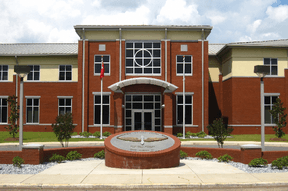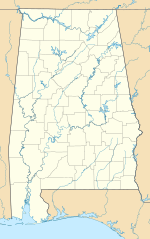Fort Novosel facts for kids
Fort Novosel is a big U.S. Army base located mostly in Dale County, Alabama. It's named after Chief Warrant Officer Michael J. Novosel, who was a brave Army pilot and received the Medal of Honor.
This base used to be called Fort Rucker. It was named after a Civil War officer from the Confederate side. The name was changed to honor a different kind of hero.
Fort Novosel is super important for the U.S. Army. It's the main place where Army pilots learn to fly. It's also home to the United States Army Aviation Center of Excellence (USAACE) and the United States Army Aviation Museum.
The base has entrances from three nearby cities: Daleville, Ozark, and Enterprise. Before the September 11, 2001 attacks, regular people could drive through most of the base. Now, it's closed to visitors unless they have special permission.
Fort Novosel was one of the military bases that was renamed. This happened because a special group called The Naming Commission suggested changing names that honored Confederate soldiers. The base officially became Fort Novosel on April 10, 2023.
Contents
What Happens at Fort Novosel?
The most important part of Fort Novosel is the U.S. Army Aviation Center of Excellence. This center teaches Army pilots and helps improve how Army aircraft are used.
Since 1973, all Army Aviation training has happened here. Even helicopter pilots and crew from the United States Air Force (USAF) and other friendly countries come here to learn.
Learning to Fly and More
Different groups at Fort Novosel help with training:
- The 1st Aviation Brigade and the 110th Aviation Brigade handle most of the Army Aviation training.
- The USAF 23d Flying Training Squadron trains Air Force helicopter pilots.
The 110th Aviation Brigade has several battalions, each with a special job:
- One battalion manages air traffic control for the base and the wider air system.
- Another battalion trains future air traffic controllers and aviation operations specialists.
- The 1st Battalion, 14th Aviation Regiment, trains pilots to fly AH-64E Apache Longbow helicopters.
- The 1st Battalion, 212th Aviation Regiment, teaches combat and night flying using UH-60 Black Hawk helicopters.
- The 1st Battalion, 223d Aviation Regiment, trains new pilots on the Eurocopter UH-72 Lakota and teaches pilots to fly the CH-47 Chinook helicopter.
Becoming a Warrant Officer
Fort Novosel is also home to the Warrant Officer Candidate School. This is where soldiers train to become warrant officers. These are highly skilled technical experts in the Army. After training, aviation warrant officers get a special Army Aviator Badge.
Other Important Facilities
Fort Novosel has many other important places, including:
- The Lyster Army Health Clinic, which is a hospital.
- The United States Army Aeromedical Research Lab, which studies how flying affects soldiers' health.
- The United States Army School of Aviation Medicine, which trains medical staff for aviation.
- The United States Army Combat Readiness/Safety Center, which helps keep soldiers safe.
- The Army Aviation Museum, which is open to the public and shows off many different aircraft.
A Look Back: History of Fort Novosel
Fort Novosel first opened on May 1, 1942, during World War II. It was originally called Ozark Triangular Division Camp, but then it was named Camp Rucker. It was named after Colonel Edmund W. Rucker, a Civil War officer.
The base was built on about 58,000 acres of land. It had enough space for thousands of soldiers. In September 1942, an airfield was built nearby to help with training. This airfield is now known as Cairns Army Airfield.
Training During Wars
During World War II, many different Army divisions trained at Camp Rucker. These included the 81st, 35th, 98th, and 66th Infantry Divisions. They learned important skills before going to fight in places like the Pacific and Europe. The base also trained other types of units, like tank crews and the Women's Army Corps.
After World War II, Camp Rucker was quiet for a few years. But it reopened in August 1950 during the Korean War. Soldiers trained here before being sent to Korea.
In October 1955, Camp Rucker officially became "Fort Rucker." It grew even more when it became a main base for helicopter training.
Renaming the Fort
In recent years, there was a national discussion about military bases named after Confederate figures. The National Defense Authorization Act for 2021 called for a committee to change these names.
The Naming Commission suggested renaming Fort Rucker to Fort Novosel. This was to honor Chief Warrant Officer Michael J. Novosel, a true Army aviation hero. The base was officially renamed on April 10, 2023.
Where is Fort Novosel?
Fort Novosel is located in southeastern Alabama. It covers a large area, mostly in Dale County. Small parts of the base are also in Coffee, Geneva, and Houston counties.
People at Fort Novosel
Many people live and work at Fort Novosel. It's a diverse community with families, soldiers, and civilians. In 2010, about 4,636 people lived on the main part of the base.
Schools at Fort Novosel
Children living on Fort Novosel can go to Ellis D. Parker Elementary School, which is right on the base. For older students, families can choose from high schools in nearby cities like Daleville, Enterprise, or Ozark.
Famous People Connected to Fort Novosel
Many interesting people have spent time at Fort Novosel, including:
- Al Gore, who later became the Vice President of the United States.
- Kris Kristofferson, a famous singer, songwriter, and actor, who trained here as a helicopter pilot.
- Brian Gay, a professional golfer.
- Rusty Greer, a former Major League Baseball player.
- Hal Morris, another former Major League Baseball player.
- Mayte Garcia, a dancer and singer.
- Leonard Byrd, a sprinter.
- James Forbes and Edgar Jones, both basketball players.
- Blake Percival, a whistleblower.
- Jeffrey N. Steenson, a religious leader.
See also
 In Spanish: Fort Novosel para niños
In Spanish: Fort Novosel para niños



